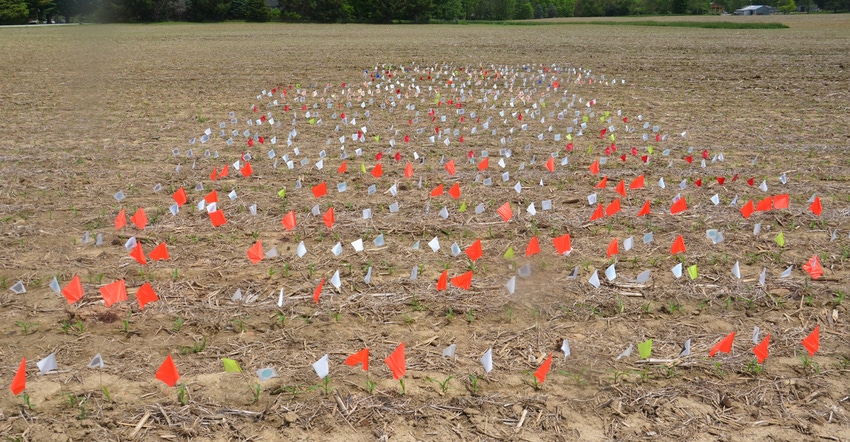
Take a good look at the picture, which shows a variety of flags within the row and row to row. This real-life example developed this spring, but it’s happened before. In fact, flagging delays in corn emergence in 1/1,000 of an acre, in each of 24 rows in one pass with a 24-row planter, was inspired because in a separate check in 2020, it was obvious that plants in different rows came up at different rates.
This 2021 case is extreme because the field was planted April 25; then it turned much cooler than anyone expected and stayed that way for over three weeks. How cool? How about frosts and freezes on multiple nights, with nightly lows in the low to mid-30s multiple nights in a row. Before it turned cool, it rained, so soils were also wet.
Dave Nanda, director of genetics for Seed Genetics Direct, notes that the deck was stacked against uniform emergence with those kinds of conditions. However, even Nanda would not have anticipated delays of up to two weeks from when the first plants emerged to when the final plants emerged.
“The other surprising thing was how much it varied from row to row across the planter,” he says. “When maybe half the plants had emerged in some rows, only a few were up in other rows. The final population didn’t vary greatly row to row, but the rate of getting to that population certainly varied.”
Possible causes
Here are possible causes for variations in emergence:
Row-to-row variation in planter rows. Steve Gauck, a regional agronomy manger for Beck’s, Greensburg, Ind., notes that even if a planter comes straight from the factory, there may be enough variation in row units from row to row to cause differences in actual planting depth at the same setting. He notes that you may have to set different rows at different settings if you want them all to drop seed at the same depth. It’s worth checking in the barn lot before you get in the field, even on a new planter.
Soil moisture variation in top few inches. There may be moisture at 2 inches below the surface where some rows run, and not where other rows go. New technology such as SmartFirmers from Precision Planting can help pick up these types of variation. If some rows are placing seed in moisture and others are not, it may create differences in germination and emergence.
Soil type variation. Twenty-four rows in 30-inch rows for a 24-row planter amounts to 60 feet. Soil characteristics can easily vary across 60 feet, including soil texture and internal soil drainage. Under adverse environmental conditions, these differences can contribute to differences in emergence.
Uneven disc opener wear. Key parts on each planter row may not wear the same, starting with disc openers but including other key components, such as closing wheels. If the trench doesn’t get formed and/or closed the same way across all rows, emergence may not be uniform.
About the Author(s)
You May Also Like




